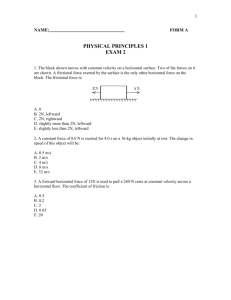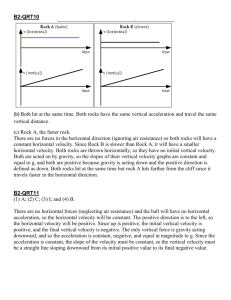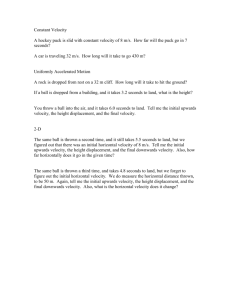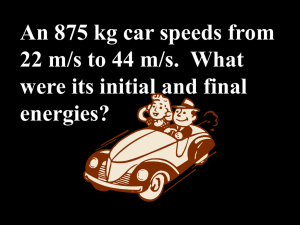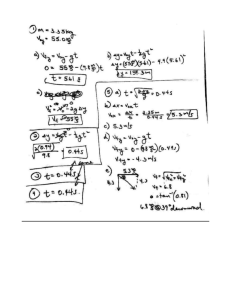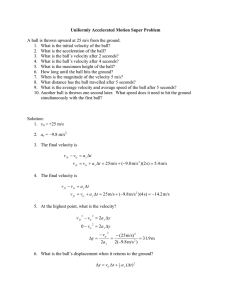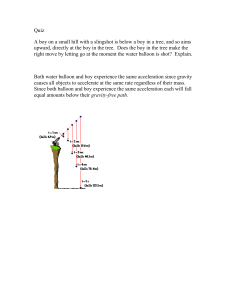Physics 12: Projectiles launched at an angle Please see the
advertisement
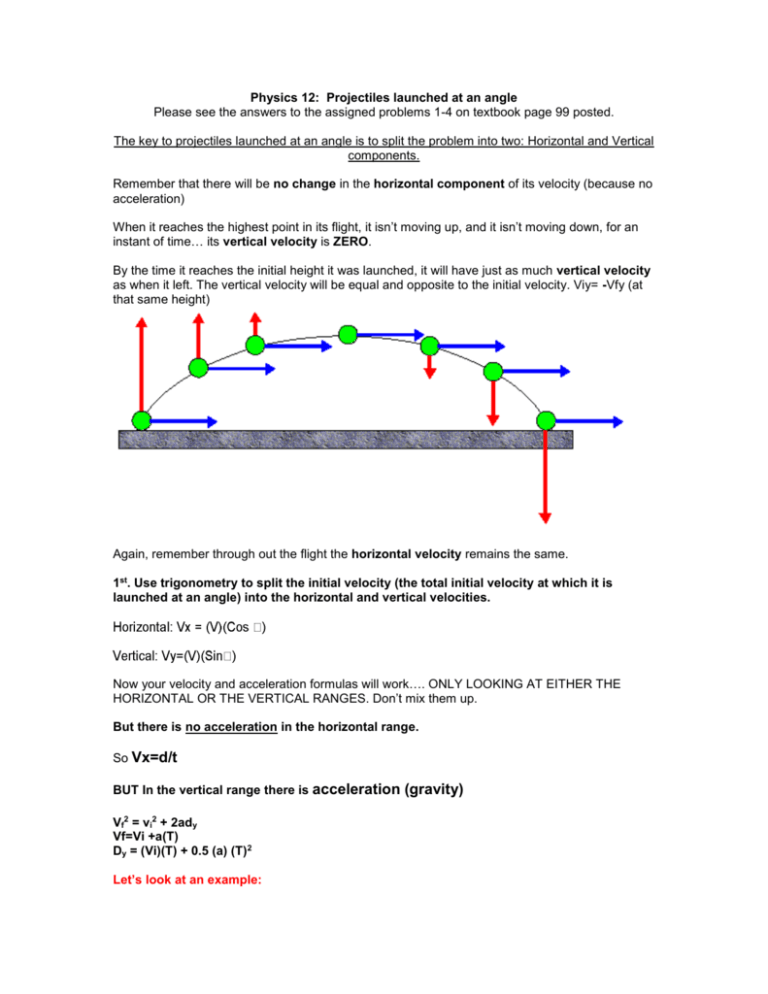
Physics 12: Projectiles launched at an angle Please see the answers to the assigned problems 1-4 on textbook page 99 posted. The key to projectiles launched at an angle is to split the problem into two: Horizontal and Vertical components. Remember that there will be no change in the horizontal component of its velocity (because no acceleration) When it reaches the highest point in its flight, it isn’t moving up, and it isn’t moving down, for an instant of time… its vertical velocity is ZERO. By the time it reaches the initial height it was launched, it will have just as much vertical velocity as when it left. The vertical velocity will be equal and opposite to the initial velocity. Viy= -Vfy (at that same height) Again, remember through out the flight the horizontal velocity remains the same. 1st. Use trigonometry to split the initial velocity (the total initial velocity at which it is launched at an angle) into the horizontal and vertical velocities. Now your velocity and acceleration formulas will work…. ONLY LOOKING AT EITHER THE HORIZONTAL OR THE VERTICAL RANGES. Don’t mix them up. But there is no acceleration in the horizontal range. So Vx=d/t BUT In the vertical range there is acceleration Vf2 = vi2 + 2ady Vf=Vi +a(T) Dy = (Vi)(T) + 0.5 (a) (T)2 Let’s look at an example: (gravity) You kick a soccer ball at an angle of 40° above the ground with a velocity of 20m/s. How high will it go? How much time does it spend in the air? How far away from you will it hit the ground (horizontal distance)? What is the ball’s velocity when it hits the ground? Before we can calculate anything else, we first need to break the original velocity into components. vertical component sinΘ = opp/hyp opp = sinΘ (hyp) sin 40° (20m/s) = vy = 13m/s horizontal component cosΘ = adj/hyp adj = cos Θ (hyp) cos 40° (20m/s) = vy = 15m/s a) TO FIND TIME we look at the VERTICAL! At its maximum height, halfway through its flight, the object won't be going up or down, so the velocity (we will call it Vpeak) at that point is zero. Vpeak2 = vif2 + 2ad d = (vf2 - vi2) / 2a = (02 - 132) / 2(9.81) d = 8.6 m The ball will reach a maximum height of 8.6 m. b) THINK VERTICAL! Same ideas as above... a = (vpeak - vi) / t t = (vpeak- vi) / a = (0 - 13) / -9.81 t = 1.3 s But this is only the time to the halfway point, so the final answer is 2.7s. c) Now we can use the time to relate to the HORIZONTAL There is no acceleration in the horiztonal range so v = d/t d = vt = 15m/s (2.7s) d = 41 m 41m is the horizontal distance (range) that it has traveled. d) The ball’s velocity when it hits the ground is exactly the same as when it was originally launched… 20 m/s at 40° up from the horizontal. The only difference is that now it's spiking into the ground. Example 2: A bouncing ball leaves the ground with a velocity of 4.36 m/s at an angle of 81 degrees above the horizontal. a) How long did it take the ball to land? b) How high did the ball bounce? c) What was the ball's range? Solutions: 1st First, determine the horizontal and vertical components of the initial velocity. vx = vi cosq = (4.36m/ s)(cos81) = 0.6821m/ s viy = vi sinq = (4.36m/ s)(sin81) = 4.3063m/ s a) Here is another way to find time….. the total displacement travelled in the vertical ( Dy) is zero. y = viy t + 1/2 at2 0m= (4.3063)t + 1/2 (-9.81 )t2 factor out t 0m= (4.3063 - 4.90t)t divid both sides by t 0m= 4.3063 - 4.905t rearrange t = 4.3060 - 4.905 t = 0.8779s Because the take-off and landing heights are the same, the parabola is completely symmetrical and the maximum height will occur at half the flight time. Therefore it will occur when time is 0.4389 seconds. y = viy t + ½ at2 y = (4.3060)(0.4389) + 1/2 (-9.81)(0.4389)2 y = 1.8899m- 0.9449m y = 0.9450m The ball will reach a maximum height of 0.95 meters. c) Solution: Dx = (vx)t Dx = (0.6821m/ s)(0.8779s) Dx = 0.5988m The ball will travel 0.60 meters down range. EXAMPLE 3: A long jumper leaves the ground with an initial velocity of 12 m/s at an angle of 28-degrees above the horizontal. Determine the time of flight, the horizontal distance, and the peak height of the long-jumper. First, use trigonometric function to determine the initial velocity components: Horiz: vix =(12 m/s) • cos (28 deg) =10.6 m/s Vert: viy =(12 m/s) • sin (28 deg) = 5.6 m/s List the known information. Horizontal Info: x = ??? vix = 10.6 m/s ax = 0 m/s/s Vertical Info: y = 0.0 m (total); ypeak = ??? viy = 5.6 m/s vypeak = 0 m/s vfy = -5.6 m/s ay = -9.8 m/s/s Use vfy = viy + ay • ttotal and vertical info to solve for time; t -5.6 = 5.6 + -9.81 T T= (-5.6 + -5.6) / (-9.81) the time of flight is 1.1 seconds (rounded from 1.1497 s). Now use x = vix • t 10.6 m/s for vix and 1.1 s for t, the x can be found to be 12.2 m (rounded from 12.1817 m) Finally, use tup = 0.5748 s and the equation ypeak = viy • tup + 0.5 • ay • tup2 with vertical info to find the y at the peak. Substituting and solving yields 1.6 m (rounded from 1.6193 m)

